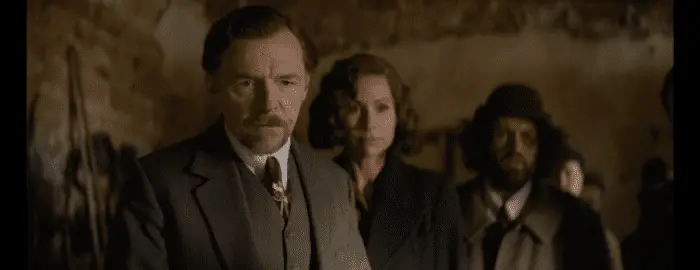EDITOR’S NOTE: This piece was written during the 2023 WGA and SAG-AFTRA strikes. Without the labor of the writers and actors currently on strike, films like Nandor Fodor and the Talking Mongoose might not exist.
There’s something about a talking animal. Whether your taste runs to Dr. Doolittle, Babe, Puss in Boots, or Planet of the Apes, anthropomorphizing an animal with a human voice can lead to great humor, adventure, even insight. Walt Disney made a career in part by bringing human qualities—including voice—to his beloved animated creatures. One might be forgiven for assuming that a film titled Nandor Fodor and the Talking Mongoose follows in this very vein. But if based on its HarryPotterMisterMagorium-like title you are tempted to bring the kiddos to a matinee for some of that talking-animal magic, you’re going to face some disappointment, for director-writer Adam Sigal’s feature is an entirely different creature altogether.
Nandor Fodor and the Talking Mongoose is, it turns out, more about the quest to see a supposedly talking mongoose than it is the actual fantastical creature of its title itself. There was, reportedly, in the 1930s indeed such a mongoose living at a farm on the Isle of Man, one whom possessed human qualities of voice and was, by reports, quite eloquent. An eminent paranormal psychologist of the day named Nandor Fodor (Mission: Impossible series star Simon Pegg), intrigued by phenomena where people develop a wholehearted belief in that which they cannot directly observe, leads an investigation, supported by his assistant Anne (Minnie Driver) and a professional colleague, Dr. Harry Price (Back to the Future‘s Christopher Lloyd), into the mysterious animal’s existence.

These are largely true events, long of legend in English lore. However, that plot summary makes the film’s narrative sound far more interesting than Nandor Fodor and the Talking Mongoose turns out to be in practice. The film itself consists largely of talk, and lots of it. It first occurs between Fodor and Price in conversation as they discuss the plans to travel to the Isle of Man, where “Gef” (pronounced “Jef,” as the mongoose is nicknamed) resides, then a long section narrated in voiceover by Dr. Price as they arrive at their destination, and then other equally long scenes of the characters discussing a fantastic creature none of them ever sees. Is he real? Can he talk? Or is Gef the Talking Mongoose a ruse perpetrated by, say, a clever ventriloquist, or a collective hallucination induced by a collective trauma?
The real-life case is so unique a curiosity it would seem almost tailor-made for the talent on hand. The real trick director-writer Adam Sigal (Chariot) has up his sleeve is to film his excellent cast—the reliable Pegg, the talented Driver, the redoubtable Lloyd—with excellent camerawork from Sara Deane (Making Time) in long, tedious scenes of the cast looking at holes in the ground where Gef the Mongoose might exist. Pegg’s Fodor is largely unliked, Driver’s Anne lacking in any observable character traits other than being his assistant, and Lloyd’s Dr. Price is wasted narrating long sections of his real-life analogue’s journals. Neil Gaiman plays a voice, briefly heard.

The film is billed as a mystery, comedy, and adventure, but lacks all three. That it is based on a true story does not necessarily make that story worth telling on film; nor does the existence of a journal composed by an academic make it a suitable script for voiceover narration. If it is as billed, Nandor Fodor and the Talking Mongoose is comedy without laughter, a mystery without resolution, and an adventure without excitement. It does not lack for a central idea: that humans can invest their faith in that which cannot truly be known remains forever a mystery of the mind, one that allows us to practice religion, join a cult, or follow a political leader. However, an idea does not by itself a successful film make.
There is, in a post-credit scene, should you make it that far, a bit of comedy, though. The cast and crew roast director-writer Sigal with a brutal slough of insults, some of which are quite amusing. For me, they turned out to be the funniest bit of the whole film, if hardly worth wading through the entire slog of its narrative to find. Between its opening minutes and its closing credits, however, laughs in this curious comedy are rare. You’ll find yourself wishing, say, that a talking mongoose would show up to enliven the proceedings.




